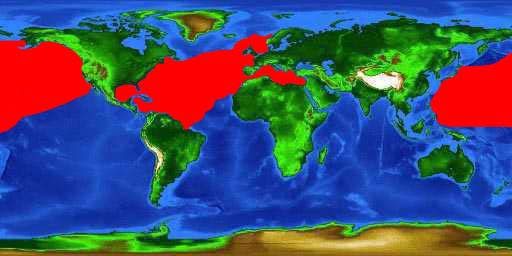
World distribution map for the bluefin tuna
Common Names |
English language common names include bluefin tuna, Atlantic bluefin tuna, blue fin tuna, bluefin tunny, blue-fin tunny, northern bluefin tuna, and squid hound. European language names include albacora (Portuguese), aleta azul (Spanish), alvacor (Portuguese), atuarro (Portuguese), atum (Portuguese), atum-azul (Portuguese), atun (Spanish), an tuinn??n (Irish) |
Geographical Distribution |
The bluefin tuna is distributed throughout the Atlantic and Pacific Oceans in subtropical and temperate waters. In the western Atlantic Ocean, it is found from Labrador, Canada, to northern Brazil, including the Gulf of Mexico. In the eastern Atlantic Ocean, it is found from Norway to the Canary Islands. In the western Pacific Ocean, it is distributed from Japan to the Philippines. In the eastern Pacific Ocean, it is distributed from the southern coast of Alaska, USA to Baja California, Mexico.?
|
|
This tuna is epipelagic and oceanic, coming near shore seasonally. It can tolerate a considerable range of temperatures and has been observed both above and below the thermocline, down to depths of greater than 3000 feet (9,850 m).
Bluefin tuna exhibit strong schooling behavior while they are young. While schooling is believed to be sight oriented, schools have been observed at night. Therefore, other senses (particularly the lateral line) appear to be involved in this behavior. Schools of bluefin seasonally migrate northward during the summer months along the coast of Japan and and the Pacific coast of North America. Tagged adult fish have made trans-Pacific migrations: some eastward, and some westward. Other tagging studies have shown that a bluefin can cross the Atlantic in less than 60 days. They can swim at speeds up to 45 mph (72.5 kph). |
|